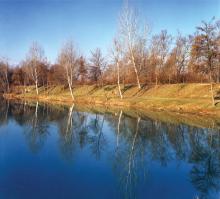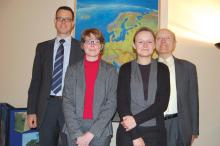
Synergies and a strong sense of common purpose have led to the merger of Germany's aggregates federation with its counterpart for sand and gravel, to form a new and expanded MIRO, led by its director general Dr Ulrich Hahn. Jon Masters reports
Amalgamation of
"We will still be fighting with common interests, but with a greater intensity. With a larger organisation and a stronger voice we can do more in the interests of German aggregate companies," said the director general of the newly expanded MIRO Dr Ulrich Hahn. A smooth transition to a larger more representative MIRO is just as well for Hahn, his colleagues and the German aggregates industry. There is no shortage of important work to do and issues to address.
"Merging BKS and MIRO was a natural progression, it made sense," Hahn said. Whereas Germany once had distinct markets for rock, and sand and gravel, recent decades have seen a converging of the markets, and of pressing issues for both sectors. "We now have common problems to tackle; of environmental pressures, health and safety, workplaces and generally of access to aggregates getting more difficult," he said. Creation of a single federation might have happened earlier, but for old allegiances to tradition. These have been replaced, however, by a stronger common sense of purpose.
Initiation of negotiations two years ago brought together aggregates sectors of roughly equal size: German sand and gravel production is currently around 240million tonnes; crushed rock output is just over 200million tonnes. The new MIRO has its main office in Cologne with a second office in Duisburg and an executive board of 29 at present (20 from MIRO, 9 from BKS), although this will be rationalised over the next two years or so, according to Hahn.
MIRO now represents about 1300 individual operators of around 2100 production sites. The majority are what Hahn describes as 'micro companies' of 10 employees or less. Given their small size, health and safety performance of German aggregate suppliers is remarkably strong, with annual levels of serious injuries in single figures. However, this is something that can always be improved, said Hahn.
Previous cooperation
Production of advisory safety documents is one area where BKS and MIRO have cooperated in recent years to avoid duplication of efforts, in the knowledge that the two organisations were likely to merge. Work on further safety initiatives will continue. As will conferences and seminars for MIRO member companies' training of personnel, on safe operations and other technical matters, harmonised European standards, laboratory testing and so forth.
Overall, it is a very broad business plan the new MIRO is working to, drawn up two years ago and so already a combined strategy for promoting the interests of both sand and gravel and crushed rock suppliers. Such representation is vital for so many small companies, for supporting new requirements stipulated by the
"In Brussels doors have been opened to allow greater extraction of raw materials across Europe, but in Germany, only small openings have been allowed so far," Hahn said. "From the commission there are often good ideas coming, such as its Raw Materials Initiative, but in Germany they are being turned from good to bad due to overly stringent interpretation of European regulations." He refers to the EC's Natura 2000 guidance, which lists geographical areas to be environmentally protected. Green groups in Germany and the German government have interpreted this as meaning no sourcing of raw materials can take place within these areas, but the EC has amended its guidance. This now states extraction is reasonable in protected areas if there is a common interest for economic purposes, and if processes are conducted to high standards of environmental mitigation. "We are requesting to the German authorities that its relatively stringent application of environmental regulations is relaxed, suggesting that a more common sense approach ought to be followed," said Hahn.
Some relaxation of German application of environmental regulation would seem to make good sense given that Germany can play its part in the Raw Materials Initiative. It is now three years since publication of the commission's three pillared strategy for supporting European economic growth by securing supply of raw materials. MIRO is working on building the case for Germany to contribute, or at least to be in a position to meet future demands.
The country's economy is back on a growth tack. Its construction industry is still shrinking. Aggregate sales volumes are expected to decrease by another 3% this financial year - on top of reductions recorded every one of the previous five years - but this is likely to change..
"It is important to show the government in Germany that there is a strong wish for keeping raw materials accessible," said Hahn, who also points to the environmental positives. Restoration of exhausted quarries for ecological benefit is part of the argument for relaxing regulations, as is Germany's waste problem. "We have a huge amount of quarrying and construction waste to deposit, but big restrictions on this," he added. The upshot of a more progressive political stance towards raw materials and waste could be a sustainable system of extraction and quarry restoration. Deposit of quarrying and construction waste would be one mitigating element of long term plans for land use.
Supporting members
Further to this, MIRO is currently working to support its members' response to other European environmental regulations, such as those relating to 'dangerous substances'. As part of this, all suppliers will be soon be required to submit specific and detailed information on the nature of leaching of aggregates and the composition of leachates. MIRO is assisting with interpretation of the rules. The aim is to ensure a standardised response with consistent testing and reporting.
In similar fashion, standardisation is the objective of MIRO's work on 'applicability of aggregates for construction processes'. According to Hahn, the ultimate output is likely to be a set of standards that would categorise all aggregates by type and their suitability for particular applications. "Followed correctly, such a system of specification will ensure correct usage of aggregate, which is particularly important for the more specialist applications," he said. "It will also aid producers by giving supporting evidence of the performance of their products. Less lengthy and time consuming laboratory testing will be needed for each concrete or asphalt material mix." Hahn is very well placed to lead on such subjects. Previously a civil engineer specialising in road construction, he joined the former MIRO as its managing director in 1981. "This was at a time when technical issues dominated and someone with strong materials knowledge and laboratory experience was needed. Now the problems are mostly environmental," he said.
This takes nothing from Hahn's standing and renowned suitability for his role. He was Director General of MIRO during the build up to its merger with BKS (and for the 14 years previous) and was elected by his peers to remain at the helm of the new MIRO.
Hahn was engaged in the development of German standards during the 1980s and from 1989 had the reunification of East and West Germany to contend with. "This was a very big issue to handle, to harmonise existing standards; a very big exercise," he says. Then came the European harmonisation process, which started in 1988. Dr Hahn has had a strong involvement in the process, chairing two of the CEN committees - CEN/TC 227 for 'Road materials' and CEN/TC 154/SC 3 'Aggregates for bituminous mixtures'.
This work also continues. Since the first harmonised standards for aggregate were published in 2003, further necessary revisions have been identified. The second generation is now being developed. "It's a never ending story," Hahn said. "In many countries these are entirely new specifications, so as training and working with the new standards beds in, there starts a further process of learning and development. It does not take long for additional necessary changes to crop up. Generally by the time two years have passed, a lot of things accumulate and so a further generation of harmonised specs is needed. It's a lot of work." Hahn's term as director general for MIRO is not a fixed one in length. Given his experience and knowledge and the amount of important work ahead, it is a safe bet he will be in the post for some time to come.









